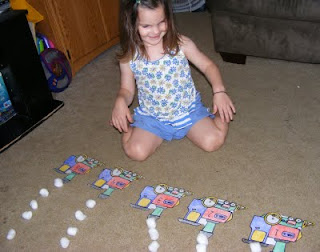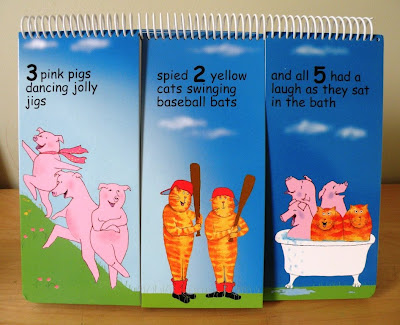Welcome! New to ABC and 123?
Please check out our FAQ in the left sidebar.
Thank you so much to today's fabulous guest writer, Elise,
Inspiration Surrounds, Creativity Abounds.
She has put together a fun resource including different ways in which old calendars can become a valuable learning tool for young children. She explains that, "old calendars, or ones that have been marked down in price as the New Year begins, are a great resource that we use a lot and I thought this post may be of use to your readers." Enjoy!
'Tis the season to stock up on calendars. In our neck of the woods, calendars have been reduced by 40%. I know that they will be cheaper once the New year rolls in, but I wanted to make sure that there was still a decent selection to choose from, so this morning I went a little crazy and bought a heap of calendars that I plan on using for some of our activivities for next year. Alternatively, ask family and friends for their old calendars.
My mind has been going into over-drive with the possibilities for our Tot School activities for next year. We are going to use themes for the week to guide our learning experiences. I have been brainstorming and mindmappping our first few weeks and am really excited about the possibilities.
I bought calendars which feature: animals (endangered species, Australian animals etc), places of interest (wonders of the world), different artists (Van Gogh, Monet), flowers, scenery, landscapes, fairies, cars and trucks. I was thinking along the lines of the different themes we will be exploring, Savvy and Blake's interests, as well as seasonal activities.
I will be cutting up the pictures from the calendars (the large pictures within the calendars and the mini ones usually found on the back of the calendars) and laminating them.
Some ideas I plan on implementing using the calendars:
Photo below: Savvy at 18 months sorting different animals.
Pictures from calendars are a wonderful visual tool that can be used for sorting and grouping purposes. You can sort animals according to their characteristics, or you can sort pictures from calendars according to size or colour. There are plenty of options.
Photo below: Another activity that Savvy enjoyed when she was around 18 months old was pulling photos out of wallets and putting them back in. The little pictures on the back of calendars are perfect for this. Also, "posting" these pictures (for example, into an empty box) is fun for toddlers.
Photo below: When Savvy was learning about colours I made up an activity for her using different coloured cards that I coloured in and she had to put each card in the matching coloured bag. However, when I do it with Blakie I will be adding to our collection of cards and I will be using pictures of cars and trucks from the calendars I bought.
Another game I made up (which is pictured in the photo below) could also be played using pictures from calendars.
The game consists of two main components:
1. A paper plate displaying four options. An arrow is spun around by each player to determine what their task is to be. Once the task is determined, the player picks up a card (a picture from a calendar)
The options are:
Question Time: What do you know about......?
You ask a question about......?
Another player asks you a question about....?
Tell a story about.....
Act like....
Sing a song about.....
For older children I would add another category: draw a picture of....
Pictures from calendars could also be used to tell stories. They can be laminated and a magnet can be secured to them so that you can use a cookie sheet to display the pictures for the purposes of storytelling.
We may use the pictures to write our own story book
Photo below: Savvy using pictures (in this case from a magazine) so that we could write a story.
We are also going to use our pictures from calendars as a starting point to create a scene. We may draw, paint or use some other medium to create the scene.
Calendar pictures can be cut into puzzles.
Calendars can also be used for matching activities. A little while ago I was reminded of a matching activity that used calendars.
Photo below: Calendar matching activity.
Now is the time to request calendars from family and friends. Money spent on calendars that have been reduced is money well spent as there are so many options when it comes to using old, or cheap calendars.







































 We recently got a fantastic new book for our home library. I am always interested in children's literature, but this one really got me excited. It's a simple concept done very well. It also happens to be perfect for my daughter, right now. Children ages 2.5-6 will enjoy it a lot.
We recently got a fantastic new book for our home library. I am always interested in children's literature, but this one really got me excited. It's a simple concept done very well. It also happens to be perfect for my daughter, right now. Children ages 2.5-6 will enjoy it a lot. The reader picks flips through the first and second set of panels finding an animal picture for each, that the story will feature. In the third section they find the picture that has both animals from panel one and two to complete the story. As the story is completed the animals add up.
The reader picks flips through the first and second set of panels finding an animal picture for each, that the story will feature. In the third section they find the picture that has both animals from panel one and two to complete the story. As the story is completed the animals add up. My daughter really likes this one:
My daughter really likes this one: Another thing that I like about this Flip Along Fun is it's sturdy laminated board book cover and pages, not only will it stand up to years of little hands using it, but you can easily use it like a desk top easel activity. Perfect for teachers to use during center times with small groups. It would be a great tool to use with parent volunteers leading small groups to review and reinforce math concepts. Students could use a book to make their own addition story, have the parent read it to them, and then copy the problem down into their math journal. To challenge the students, you could also have them reverse the problem into a subtraction problem.
Another thing that I like about this Flip Along Fun is it's sturdy laminated board book cover and pages, not only will it stand up to years of little hands using it, but you can easily use it like a desk top easel activity. Perfect for teachers to use during center times with small groups. It would be a great tool to use with parent volunteers leading small groups to review and reinforce math concepts. Students could use a book to make their own addition story, have the parent read it to them, and then copy the problem down into their math journal. To challenge the students, you could also have them reverse the problem into a subtraction problem.










.jpg)




.jpg)
